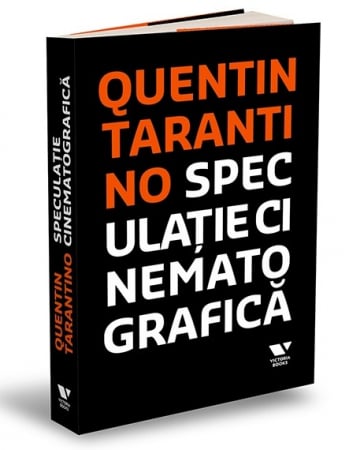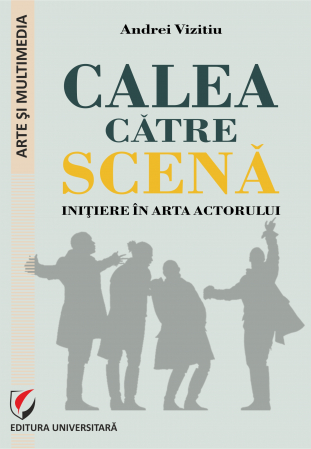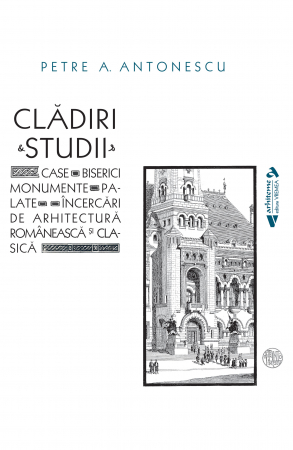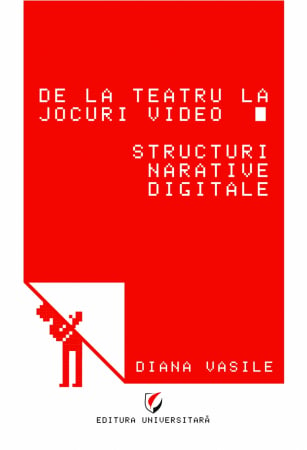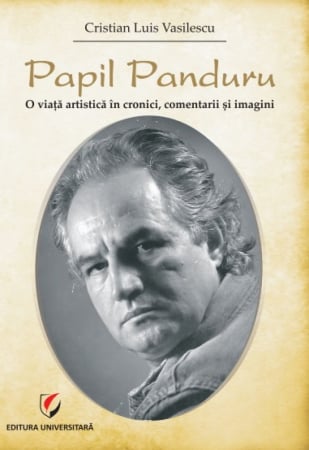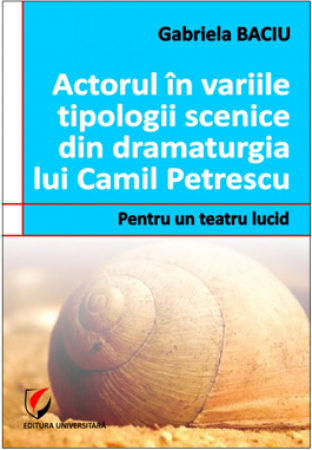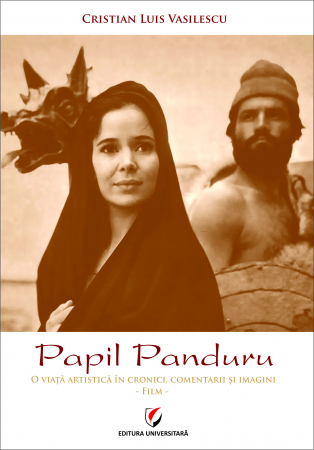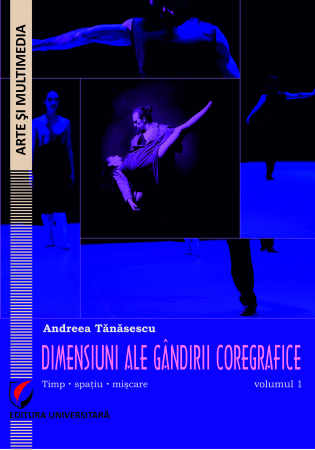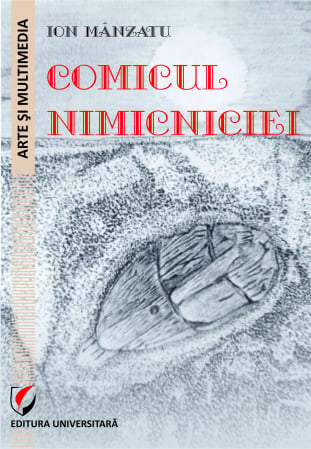Manuscript proposals: [email protected] / 0745 204 115 //// Tracking orders Individuals / Sales: 0745 200 357 / Orders Legal entities: 0721 722 783
ISBN: 978-606-28-1381-9
DOI: https://doi.org/10.5682/9786062813819
Publisher year: 2021
Edition: I
Pages: 236
Publisher: Editura Universitară
Author: Ana Agopian
Product Code:
9786062813819
Do you need help?
0745 200 357
- Description
- Download (1)
- Authors
- Content
- More details
- Reviews (0)
Film theorists, writers or professionals active in the world of film have written about the possibility of looking at screenwriting as a literary form. George Garrett, a poet and novelist, notes in the introduction to a volume of screenplays: "This remarkable collection of screenplays could very well be a true manifestation of 20th century literature." Writer Sam Thomas considers it important to "recognize and admit that the screenplay for the film, in its most successful form, can and should be considered literature as much as a novel or a play of great significance." Russian director Andrey Tarkovsky states the exact opposite: "I don't see the screenplay as a literary genre. Indeed, the more cinematic a script is, the less it can claim a stand-alone literary status, in the way a play can do so often. And we know that in practice no script has ever been in literature. " Paul Schrader, screenwriter of "Raging Bull" and "Taxi Driver," the famous Martin Scorsese-directed film, insisted that "I'm not a writer. I'm a screenwriter, that is, half a director. " And Swedish director Ingmar Bergman admitted that "film has nothing to do with literature." In 1984, Gary Davis, a film theorist quoted by Stevan Maras, wrote:
Currently, the subject has not been resolved. Working as a screenwriter in Romania, I co-signed, with Oana Rasuceanu and Iulia Rugina, the feature films Love Building, Alt Love Building and Breaking News, the medium-length film Captive for Christmas and the short films To die of hurt love, Hello, Cristina! Goodbye Cristina and, most recently, ET was here, for which I also signed directing. I often found myself in discussions about the specificity of the script and about the possibility of its inclusion in the literary species. My feeling, before starting an academic approach in this regard, was not only that the screenplay is not a literary species, but that the vast majority of professionals active in the film industry have the same opinion. Approaching the subject, I understood that things are much more nuanced than I thought, and the often contradictory opinions on this topic, pertinent on each side, are due to the complexity of the issue discussed. Is the script a literary form? it is a question that theorists, practitioners or film critics have tried to answer since the appearance of this form of text, and a categorical and unanimously accepted statement has not been formulated so far. Reading about the topic, I understood that from the point of view of a filmmaker, the subject is broken, and the possible paths are always a dead end.
In this paper I want to approach the issue from a new perspective, which has not been taken into account so far. Two film theorists, Barbara Korte and Ralf Schneider, state, "A text may or may not be considered literature because of the way it is viewed by the literary community and literary institutions." Film theorists have explored the possibility of analyzing a script from a literary point of view, but the topic has not been treated in the opposite direction: from the point of view of a writer, the script viewed as an artistic species. I graduated from the "I.L. Caragiale" University of Theater and Cinematography, a university environment where the field is constantly studied and where, in fact, I also profess, being a university lecturer in the screenwriting department. However, I propose that this study be done in the opposite direction: from literature to screenwriting. Taking into account my training as a screenwriter, the knowledge in the field that I acquired after several years of writing screenplays (some of them even published) and teaching screenwriting, I intend to think like a writer. A filmmaker who proposes a study from literature to screenwriting to find new nuances and perspectives on a subject so far most often approached in the opposite direction.
Currently, the subject has not been resolved. Working as a screenwriter in Romania, I co-signed, with Oana Rasuceanu and Iulia Rugina, the feature films Love Building, Alt Love Building and Breaking News, the medium-length film Captive for Christmas and the short films To die of hurt love, Hello, Cristina! Goodbye Cristina and, most recently, ET was here, for which I also signed directing. I often found myself in discussions about the specificity of the script and about the possibility of its inclusion in the literary species. My feeling, before starting an academic approach in this regard, was not only that the screenplay is not a literary species, but that the vast majority of professionals active in the film industry have the same opinion. Approaching the subject, I understood that things are much more nuanced than I thought, and the often contradictory opinions on this topic, pertinent on each side, are due to the complexity of the issue discussed. Is the script a literary form? it is a question that theorists, practitioners or film critics have tried to answer since the appearance of this form of text, and a categorical and unanimously accepted statement has not been formulated so far. Reading about the topic, I understood that from the point of view of a filmmaker, the subject is broken, and the possible paths are always a dead end.
In this paper I want to approach the issue from a new perspective, which has not been taken into account so far. Two film theorists, Barbara Korte and Ralf Schneider, state, "A text may or may not be considered literature because of the way it is viewed by the literary community and literary institutions." Film theorists have explored the possibility of analyzing a script from a literary point of view, but the topic has not been treated in the opposite direction: from the point of view of a writer, the script viewed as an artistic species. I graduated from the "I.L. Caragiale" University of Theater and Cinematography, a university environment where the field is constantly studied and where, in fact, I also profess, being a university lecturer in the screenwriting department. However, I propose that this study be done in the opposite direction: from literature to screenwriting. Taking into account my training as a screenwriter, the knowledge in the field that I acquired after several years of writing screenplays (some of them even published) and teaching screenwriting, I intend to think like a writer. A filmmaker who proposes a study from literature to screenwriting to find new nuances and perspectives on a subject so far most often approached in the opposite direction.
-
The screenplay as a literary species
Download
ANA AGOPIAN
ARGUMENT / 9
SCENARIO AS A LITERARY SPECIES - CONTEXT AND BRIEF HISTORY / 18
The appearance of the script and the formation of the term screenwriter / 18
The first forms of scenario. Proto ‑ the scenario and the reasons for its appearance / 20
Debates on the script as a literary species / 27
Arguments that deny that the script is a literary species / 28
Arguments attesting the script as a literary species / 39
Conclusions regarding the debates about the script as a literary species and the perspective of a comparative analysis / 60
COMPARATIVE ANALYSIS / 62
Definition, formatting rules and screenwriting. Screenwriting vs. literature / 62
For a new novel. Alain Robbe ‑ Grillet. Scenario Vs. Romanian. Cine ‑ roman vs. scenario / 77
Screenwriting Techniques vs. literary writing techniques / 97
THE ADAPTATION. COMPARATIVE ANALYSIS BETWEEN A SCENARIO AND THE ORIGINAL LITERARY TEXT / 128
Text analysis / 137
Conclusions / 161
WHAT IS LITERATURE? POSSIBILITIES OF SCRIPT FRAMEWORK AS A LITERARY FORM / 163
Linguistic perspective / 165
Semantic perspective / 168
Literature - act of eloquence / 171
Aesthetic perspective / 173
Cognitive Perspective / 174
Institutional perspective / 176
Style and time trial / 178
The perspective of social practice / 182
Approaching family resemblance / 184
The novel or the indefinite genre / 185
The novel - defined by the length of the text / 189
Conclusions / 190
CASE STUDY / 192
The non-specialized reader. Reporting to the script / 192
CONCLUSIONS / 200
ANNEXES / 208
Questionnaire to non-specialized readers / 208
BIBLIOGRAPHY / 226
SCENARIO AS A LITERARY SPECIES - CONTEXT AND BRIEF HISTORY / 18
The appearance of the script and the formation of the term screenwriter / 18
The first forms of scenario. Proto ‑ the scenario and the reasons for its appearance / 20
Debates on the script as a literary species / 27
Arguments that deny that the script is a literary species / 28
Arguments attesting the script as a literary species / 39
Conclusions regarding the debates about the script as a literary species and the perspective of a comparative analysis / 60
COMPARATIVE ANALYSIS / 62
Definition, formatting rules and screenwriting. Screenwriting vs. literature / 62
For a new novel. Alain Robbe ‑ Grillet. Scenario Vs. Romanian. Cine ‑ roman vs. scenario / 77
Screenwriting Techniques vs. literary writing techniques / 97
THE ADAPTATION. COMPARATIVE ANALYSIS BETWEEN A SCENARIO AND THE ORIGINAL LITERARY TEXT / 128
Text analysis / 137
Conclusions / 161
WHAT IS LITERATURE? POSSIBILITIES OF SCRIPT FRAMEWORK AS A LITERARY FORM / 163
Linguistic perspective / 165
Semantic perspective / 168
Literature - act of eloquence / 171
Aesthetic perspective / 173
Cognitive Perspective / 174
Institutional perspective / 176
Style and time trial / 178
The perspective of social practice / 182
Approaching family resemblance / 184
The novel or the indefinite genre / 185
The novel - defined by the length of the text / 189
Conclusions / 190
CASE STUDY / 192
The non-specialized reader. Reporting to the script / 192
CONCLUSIONS / 200
ANNEXES / 208
Questionnaire to non-specialized readers / 208
BIBLIOGRAPHY / 226
Film theorists, writers or professionals active in the world of film have written about the possibility of looking at screenwriting as a literary form. George Garrett, a poet and novelist, notes in the introduction to a volume of screenplays: "This remarkable collection of screenplays could very well be a true manifestation of 20th century literature." Writer Sam Thomas considers it important to "recognize and admit that the screenplay for the film, in its most successful form, can and should be considered literature as much as a novel or a play of great significance." Russian director Andrey Tarkovsky states the exact opposite: "I don't see the screenplay as a literary genre. Indeed, the more cinematic a script is, the less it can claim a stand-alone literary status, in the way a play can do so often. And we know that in practice no script has ever been in literature. " Paul Schrader, screenwriter of "Raging Bull" and "Taxi Driver," the famous Martin Scorsese-directed film, insisted that "I'm not a writer. I'm a screenwriter, that is, half a director. " And Swedish director Ingmar Bergman admitted that "film has nothing to do with literature." In 1984, Gary Davis, a film theorist quoted by Stevan Maras, wrote:
Currently, the subject has not been resolved. Working as a screenwriter in Romania, I co-signed, with Oana Rasuceanu and Iulia Rugina, the feature films Love Building, Alt Love Building and Breaking News, the medium-length film Captive for Christmas and the short films To die of hurt love, Hello, Cristina! Goodbye Cristina and, most recently, ET was here, for which I also signed directing. I often found myself in discussions about the specificity of the script and about the possibility of its inclusion in the literary species. My feeling, before starting an academic approach in this regard, was not only that the screenplay is not a literary species, but that the vast majority of professionals active in the film industry have the same opinion. Approaching the subject, I understood that things are much more nuanced than I thought, and the often contradictory opinions on this topic, pertinent on each side, are due to the complexity of the issue discussed. Is the script a literary form? it is a question that theorists, practitioners or film critics have tried to answer since the appearance of this form of text, and a categorical and unanimously accepted statement has not been formulated so far. Reading about the topic, I understood that from the point of view of a filmmaker, the subject is broken, and the possible paths are always a dead end.
In this paper I want to approach the issue from a new perspective, which has not been taken into account so far. Two film theorists, Barbara Korte and Ralf Schneider, state, "A text may or may not be considered literature because of the way it is viewed by the literary community and literary institutions." Film theorists have explored the possibility of analyzing a script from a literary point of view, but the topic has not been treated in the opposite direction: from the point of view of a writer, the script viewed as an artistic species. I graduated from the "I.L. Caragiale" University of Theater and Cinematography, a university environment where the field is constantly studied and where, in fact, I also profess, being a university lecturer in the screenwriting department. However, I propose that this study be done in the opposite direction: from literature to screenwriting. Taking into account my training as a screenwriter, the knowledge in the field that I acquired after several years of writing screenplays (some of them even published) and teaching screenwriting, I intend to think like a writer. A filmmaker who proposes a study from literature to screenwriting to find new nuances and perspectives on a subject so far most often approached in the opposite direction.
In this paper I want to approach the issue from a new perspective, which has not been taken into account so far. Two film theorists, Barbara Korte and Ralf Schneider, state, "A text may or may not be considered literature because of the way it is viewed by the literary community and literary institutions." Film theorists have explored the possibility of analyzing a script from a literary point of view, but the topic has not been treated in the opposite direction: from the point of view of a writer, the script viewed as an artistic species. I graduated from the "I.L. Caragiale" University of Theater and Cinematography, a university environment where the field is constantly studied and where, in fact, I also profess, being a university lecturer in the screenwriting department. However, I propose that this study be done in the opposite direction: from literature to screenwriting. Taking into account my training as a screenwriter, the knowledge in the field that I acquired after several years of writing screenplays (some of them even published) and teaching screenwriting, I intend to think like a writer. A filmmaker who proposes a study from literature to screenwriting to find new nuances and perspectives on a subject so far most often approached in the opposite direction.
"Looking back on the attempts in the 1940s to define the script as a form of literature, it would be expected that it would have laid the groundwork for a period of sustained study of the script, or at least the script. However, this did not happen, "said theorist Steven Maras in his 2009 Screenwriting - History, Theory and Practice. of the script. Steven Maras with the aforementioned work, Ian W. Macdonald (Screenwriting Poetics and the Screen Idea), Steven Price (The Screenplay - Authorship, Theory and Criticism) or Ted Nannicelli (A Philosophy of the Screenplay) are just some of the important theorists who they have recently deepened the possibilities of framing or the specificity of the scenario. Each time, however, the discussion of the script as a literary form was restricted to a single chapter of their research, each of them summarizing the most important opinions in the field and reaching, following them, relevant conclusions. However, none of them proposed an in-depth analysis of the text that would lead them to a position in relation to the subject approached. However, a text study has been done, even Steven Price mentions two important researches. Richard Corliss in Talking Pictures (1974) analyzes 100 screenplays written by 35 screenwriters, and Claudia Sternberg uses no less than 43 screenplays for her research in Written for the Screen: The American Motion - Picture Screenplay as text. . Such studies are important in the general context of research into the possibilities of defining the scenario, but the conclusions are often limiting. Following the analysis of some scenarios (no matter how vast their number), it can be stated only that those specific texts belong to the literary genre and not to the belonging of the whole species to the mentioned category. Because the script was rarely studied by writers, the research was not done in reverse: from literary texts to screenplays, from literary writing techniques to screenwriting techniques, or from literary definitions to those applicable to screenwriting rules. When we can show that forms of literature closely follow the rules of screenwriting, we will be closer to the possibility of stating that the screenplay is a literary species. This is because it would be much harder for us to deny the character of the texts studied and already generally accepted as samples of literature, studied in schools and universities, analyzed by critics and introduced in histories. Therefore, we intend to question the possibility of looking at certain literary texts, even if only for the purpose of this research, as real scenarios. And if a literary text can be seen as a script, then any script written according to the rules applied to the studied text acquires literary status. We also want to put literary and screenwriting techniques face to face and analyze the genesis of the latter. To offer possible definitions of literature and to apply them not to certain scenarios in particular, but to all of them, referring to the rules of writing used and spread in the industry. Only in this way do we consider that we can offer an answer that is not particular for certain scenarios, but general for all of them.
A first step will be a look back at a context and a brief history of the topic, to draw the main directions and sets of opinions that have so far been expressed by theorists in the field. It is important to review the history of this species analyzed and discussed. Proto ‑ the script and its first forms will be mentioned, precisely because the early origins of these forms of text have a direct connection with the reception of the later script. We also want to exemplify the arguments that deny that the script is a literary form, but also those that attest to it. We do not intend a continuation of them and the way of arguing so far, but a comparative analysis that nuances the opinions offered and offers a new perspective of their interpretation. Only after gaining an overview of the debates in the field will we move on to the next step: researching texts, rules and definitions for the proposed comparative analysis.
The first stage of the second chapter of the paper is a development of the definition of formatting rules and screenwriting. We consider the view of literary texts as possible scenarios, but first we will have to define them in terms of the rules of writing, their specificity not being relevant in this approach. The real time, the obsession of the image for the screenwriter, the emotions, the states and the morality of the characters, the omniscient narrator and the dialogue will be stated briefly, to be then applied in the analysis of literary texts. The next step will be the study from the script perspective of two literary texts. We propose the stories A Simple Operation by Ernest Hemingway and A Perfect Day for Banana Fish by J.D. Salinger to "check" their possible script status. We will try to find an answer to the question: How many of the rules of screenwriting are followed by them? If we follow closely the specificity of the scripts, we can say that they represent forms of literature that help us in trying to define the script as a literary species.
A comparative analysis between Alain Robbe ‑ Grillet's novels and screenplays, but also between his screenplays and other representative texts of the species is the third part of the chapter. We argue that both the novels and the screenplays of Robbe-Grillet, recognized as literary forms, are more technical texts, more rigid in terms of stylistic specificity imposed and more difficult to receive by a non-specialist reader than the "classic" screenplays.
The scriptwriting techniques will be put face to face with the literary ones in the last part of the chapter. We aim to define the origins of screenwriting techniques and to question the possibility that they may not, in fact, be so original. From Aristotle onwards, the rules for future playwrights were grounded, and then other literary forms were borrowed and developed. The last one, scriptwriting, was the one that had to develop the fastest. The transformation of film into a substantial revenue industry has created a need to evolve the possibilities of screenwriters, which has led to the appearance of numerous textbooks called How to write a good script. Did the so-called screenwriting gurus create the ones that teach future authors how to write an Oscar-worthy text, the rules of writing? Or did they borrow them from another distant relative, part of the family called literature? Attitude, personality and biography of the protagonist, character contradiction, plausibility and consistency, the possibility that the author loves his character, documentation, subtext, self-knowledge, triggering incident, lack and purpose of the protagonist, his evolution / change, secondary characters, three-act structure, respectively in five, the antagonist and the conflict, the sequence, the location of the action, the subject and the dialogue will be analyzed comparatively: literary vs. script. It has often been said that screenwriting borrows from literary writing techniques, but the argument has stopped here. That is why we propose an extensive comparative analysis of the most important literary and screenwriting techniques.
According to Steven Price, four-fifths of the films nominated for the American Academy Awards are based on adapted screenplays. The comparative analysis continues in a new chapter dedicated to adaptation. We initially intend to outline the main ways to transform a literary text into a script and the theoretical approaches related to the study of adaptation, and then to make a comparison between a literary text and the resulting scenario. We will question one of the main opinions conveyed on the subject: the source text will always be superior to the script, considered excessively categorical. We question the possibility of the existence of three variants: the scenario is inferior, equal or superior to the original text and we focus in the present study on the third one. If this variant is real, we will be able to put two texts face to face: one considered a literary species and another being superior in terms of literary quality, but not benefiting from the same status.
Attempts to define the script as literature "tend to fall victim to related problems of defining literature and constructing evaluation criteria that determine whether a particular text or even an entire genre deserves to be part of the canon." If a definition of literature is not generally accepted, in chapter four we aim to list its most important perspectives and the possibility of their applicability to scenarios. We do not consider the exemplification by specific scenarios and their framing according to certain perspectives, but we propose to report to the rules and techniques of screenwriting, thus showing the belonging of all scenarios that comply with the same rules to those definitions. Linguistic, semantic perspective, literature seen as an act of eloquence, aesthetic definition, cognitive, institutional or social practice, approach to family resemblance and stylistic reporting and through the test of time will be developed by constantly comparing literature and scenarios and questioning the possibilities of framing of the latter. At the end of the chapter, the approach will be broadened: we will also draw possible definitions of the novel in order to question whether the script is not, in fact, an atypical form of it.
At the end of the research we intend to conduct a case study in which we will discuss, analyze and compare the opinions of readers. These are the ones that are talked about so much, but they rarely talk about the experience of reading a script. Following the comparative analysis, we will draw possible links between literary and screenwriting texts, we will refer to literary texts from a screenwriting perspective, researching the possibility that they are, in fact, without the will of their authors, some examples of scenarios. We will also research, comparatively, screenwriting and literary writing techniques. In fact, we will talk about the creation and reception of a screenplay: the techniques referring to the creation and the constant comparison with authors of literature devoted to the possible reception of the screenplays. But to conclude the study we consider important the point of view of those we are talking about, that of the readers.
Currently, the subject has not been resolved. Working as a screenwriter in Romania, I co-signed, with Oana Rasuceanu and Iulia Rugina, the feature films Love Building, Alt Love Building and Breaking News, the medium-length film Captive for Christmas and the short films To die of hurt love, Hello, Cristina! Goodbye Cristina and, most recently, ET was here, for which I also signed directing. I often found myself in discussions about the specificity of the script and about the possibility of its inclusion in the literary species. My feeling, before starting an academic approach in this regard, was not only that the screenplay is not a literary species, but that the vast majority of professionals active in the film industry have the same opinion. Approaching the subject, I understood that things are much more nuanced than I thought, and the often contradictory opinions on this topic, pertinent on each side, are due to the complexity of the issue discussed. Is the script a literary form? it is a question that theorists, practitioners or film critics have tried to answer since the appearance of this form of text, and a categorical and unanimously accepted statement has not been formulated so far. Reading about the topic, I understood that from the point of view of a filmmaker, the subject is broken, and the possible paths are always a dead end.
In this paper I want to approach the issue from a new perspective, which has not been taken into account so far. Two film theorists, Barbara Korte and Ralf Schneider, state, "A text may or may not be considered literature because of the way it is viewed by the literary community and literary institutions." Film theorists have explored the possibility of analyzing a script from a literary point of view, but the topic has not been treated in the opposite direction: from the point of view of a writer, the script viewed as an artistic species. I graduated from the "I.L. Caragiale" University of Theater and Cinematography, a university environment where the field is constantly studied and where, in fact, I also profess, being a university lecturer in the screenwriting department. However, I propose that this study be done in the opposite direction: from literature to screenwriting. Taking into account my training as a screenwriter, the knowledge in the field that I acquired after several years of writing screenplays (some of them even published) and teaching screenwriting, I intend to think like a writer. A filmmaker who proposes a study from literature to screenwriting to find new nuances and perspectives on a subject so far most often approached in the opposite direction.
In this paper I want to approach the issue from a new perspective, which has not been taken into account so far. Two film theorists, Barbara Korte and Ralf Schneider, state, "A text may or may not be considered literature because of the way it is viewed by the literary community and literary institutions." Film theorists have explored the possibility of analyzing a script from a literary point of view, but the topic has not been treated in the opposite direction: from the point of view of a writer, the script viewed as an artistic species. I graduated from the "I.L. Caragiale" University of Theater and Cinematography, a university environment where the field is constantly studied and where, in fact, I also profess, being a university lecturer in the screenwriting department. However, I propose that this study be done in the opposite direction: from literature to screenwriting. Taking into account my training as a screenwriter, the knowledge in the field that I acquired after several years of writing screenplays (some of them even published) and teaching screenwriting, I intend to think like a writer. A filmmaker who proposes a study from literature to screenwriting to find new nuances and perspectives on a subject so far most often approached in the opposite direction.
"Looking back on the attempts in the 1940s to define the script as a form of literature, it would be expected that it would have laid the groundwork for a period of sustained study of the script, or at least the script. However, this did not happen, "said theorist Steven Maras in his 2009 Screenwriting - History, Theory and Practice. of the script. Steven Maras with the aforementioned work, Ian W. Macdonald (Screenwriting Poetics and the Screen Idea), Steven Price (The Screenplay - Authorship, Theory and Criticism) or Ted Nannicelli (A Philosophy of the Screenplay) are just some of the important theorists who they have recently deepened the possibilities of framing or the specificity of the scenario. Each time, however, the discussion of the script as a literary form was restricted to a single chapter of their research, each of them summarizing the most important opinions in the field and reaching, following them, relevant conclusions. However, none of them proposed an in-depth analysis of the text that would lead them to a position in relation to the subject approached. However, a text study has been done, even Steven Price mentions two important researches. Richard Corliss in Talking Pictures (1974) analyzes 100 screenplays written by 35 screenwriters, and Claudia Sternberg uses no less than 43 screenplays for her research in Written for the Screen: The American Motion - Picture Screenplay as text. . Such studies are important in the general context of research into the possibilities of defining the scenario, but the conclusions are often limiting. Following the analysis of some scenarios (no matter how vast their number), it can be stated only that those specific texts belong to the literary genre and not to the belonging of the whole species to the mentioned category. Because the script was rarely studied by writers, the research was not done in reverse: from literary texts to screenplays, from literary writing techniques to screenwriting techniques, or from literary definitions to those applicable to screenwriting rules. When we can show that forms of literature closely follow the rules of screenwriting, we will be closer to the possibility of stating that the screenplay is a literary species. This is because it would be much harder for us to deny the character of the texts studied and already generally accepted as samples of literature, studied in schools and universities, analyzed by critics and introduced in histories. Therefore, we intend to question the possibility of looking at certain literary texts, even if only for the purpose of this research, as real scenarios. And if a literary text can be seen as a script, then any script written according to the rules applied to the studied text acquires literary status. We also want to put literary and screenwriting techniques face to face and analyze the genesis of the latter. To offer possible definitions of literature and to apply them not to certain scenarios in particular, but to all of them, referring to the rules of writing used and spread in the industry. Only in this way do we consider that we can offer an answer that is not particular for certain scenarios, but general for all of them.
A first step will be a look back at a context and a brief history of the topic, to draw the main directions and sets of opinions that have so far been expressed by theorists in the field. It is important to review the history of this species analyzed and discussed. Proto ‑ the script and its first forms will be mentioned, precisely because the early origins of these forms of text have a direct connection with the reception of the later script. We also want to exemplify the arguments that deny that the script is a literary form, but also those that attest to it. We do not intend a continuation of them and the way of arguing so far, but a comparative analysis that nuances the opinions offered and offers a new perspective of their interpretation. Only after gaining an overview of the debates in the field will we move on to the next step: researching texts, rules and definitions for the proposed comparative analysis.
The first stage of the second chapter of the paper is a development of the definition of formatting rules and screenwriting. We consider the view of literary texts as possible scenarios, but first we will have to define them in terms of the rules of writing, their specificity not being relevant in this approach. The real time, the obsession of the image for the screenwriter, the emotions, the states and the morality of the characters, the omniscient narrator and the dialogue will be stated briefly, to be then applied in the analysis of literary texts. The next step will be the study from the script perspective of two literary texts. We propose the stories A Simple Operation by Ernest Hemingway and A Perfect Day for Banana Fish by J.D. Salinger to "check" their possible script status. We will try to find an answer to the question: How many of the rules of screenwriting are followed by them? If we follow closely the specificity of the scripts, we can say that they represent forms of literature that help us in trying to define the script as a literary species.
A comparative analysis between Alain Robbe ‑ Grillet's novels and screenplays, but also between his screenplays and other representative texts of the species is the third part of the chapter. We argue that both the novels and the screenplays of Robbe-Grillet, recognized as literary forms, are more technical texts, more rigid in terms of stylistic specificity imposed and more difficult to receive by a non-specialist reader than the "classic" screenplays.
The scriptwriting techniques will be put face to face with the literary ones in the last part of the chapter. We aim to define the origins of screenwriting techniques and to question the possibility that they may not, in fact, be so original. From Aristotle onwards, the rules for future playwrights were grounded, and then other literary forms were borrowed and developed. The last one, scriptwriting, was the one that had to develop the fastest. The transformation of film into a substantial revenue industry has created a need to evolve the possibilities of screenwriters, which has led to the appearance of numerous textbooks called How to write a good script. Did the so-called screenwriting gurus create the ones that teach future authors how to write an Oscar-worthy text, the rules of writing? Or did they borrow them from another distant relative, part of the family called literature? Attitude, personality and biography of the protagonist, character contradiction, plausibility and consistency, the possibility that the author loves his character, documentation, subtext, self-knowledge, triggering incident, lack and purpose of the protagonist, his evolution / change, secondary characters, three-act structure, respectively in five, the antagonist and the conflict, the sequence, the location of the action, the subject and the dialogue will be analyzed comparatively: literary vs. script. It has often been said that screenwriting borrows from literary writing techniques, but the argument has stopped here. That is why we propose an extensive comparative analysis of the most important literary and screenwriting techniques.
According to Steven Price, four-fifths of the films nominated for the American Academy Awards are based on adapted screenplays. The comparative analysis continues in a new chapter dedicated to adaptation. We initially intend to outline the main ways to transform a literary text into a script and the theoretical approaches related to the study of adaptation, and then to make a comparison between a literary text and the resulting scenario. We will question one of the main opinions conveyed on the subject: the source text will always be superior to the script, considered excessively categorical. We question the possibility of the existence of three variants: the scenario is inferior, equal or superior to the original text and we focus in the present study on the third one. If this variant is real, we will be able to put two texts face to face: one considered a literary species and another being superior in terms of literary quality, but not benefiting from the same status.
Attempts to define the script as literature "tend to fall victim to related problems of defining literature and constructing evaluation criteria that determine whether a particular text or even an entire genre deserves to be part of the canon." If a definition of literature is not generally accepted, in chapter four we aim to list its most important perspectives and the possibility of their applicability to scenarios. We do not consider the exemplification by specific scenarios and their framing according to certain perspectives, but we propose to report to the rules and techniques of screenwriting, thus showing the belonging of all scenarios that comply with the same rules to those definitions. Linguistic, semantic perspective, literature seen as an act of eloquence, aesthetic definition, cognitive, institutional or social practice, approach to family resemblance and stylistic reporting and through the test of time will be developed by constantly comparing literature and scenarios and questioning the possibilities of framing of the latter. At the end of the chapter, the approach will be broadened: we will also draw possible definitions of the novel in order to question whether the script is not, in fact, an atypical form of it.
At the end of the research we intend to conduct a case study in which we will discuss, analyze and compare the opinions of readers. These are the ones that are talked about so much, but they rarely talk about the experience of reading a script. Following the comparative analysis, we will draw possible links between literary and screenwriting texts, we will refer to literary texts from a screenwriting perspective, researching the possibility that they are, in fact, without the will of their authors, some examples of scenarios. We will also research, comparatively, screenwriting and literary writing techniques. In fact, we will talk about the creation and reception of a screenplay: the techniques referring to the creation and the constant comparison with authors of literature devoted to the possible reception of the screenplays. But to conclude the study we consider important the point of view of those we are talking about, that of the readers.
If you want to express your opinion about this product you can add a review.
write a review

6359.png)
![The screenplay as a literary species [1] The screenplay as a literary species [1]](https://gomagcdn.ro/domains/editurauniversitara.ro/files/product/large/coperta-1-scenariul-5465-8134.jpg)
